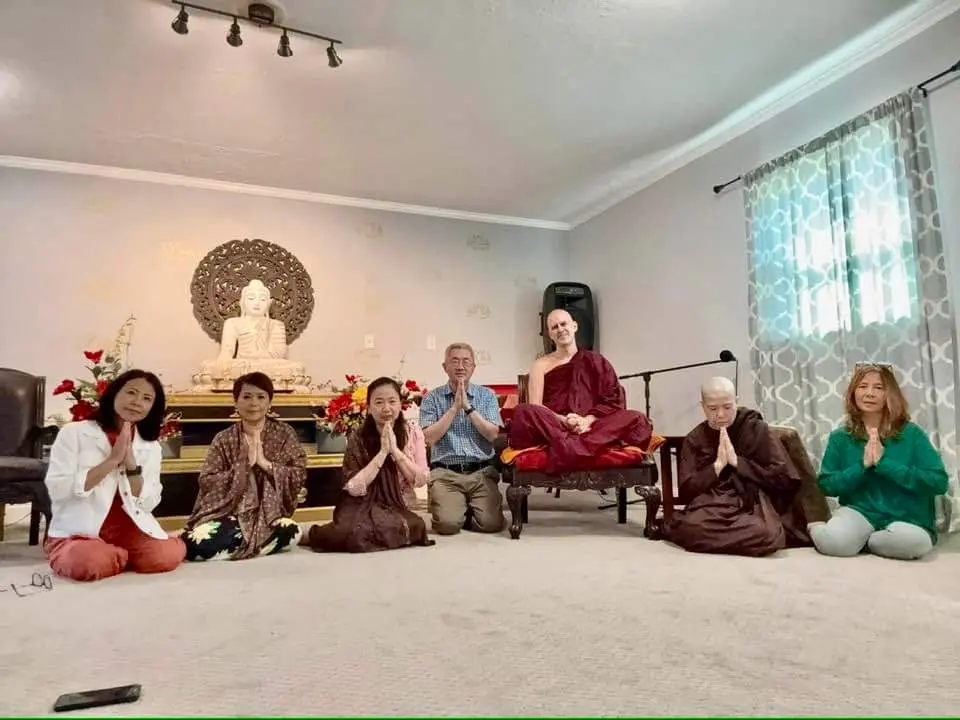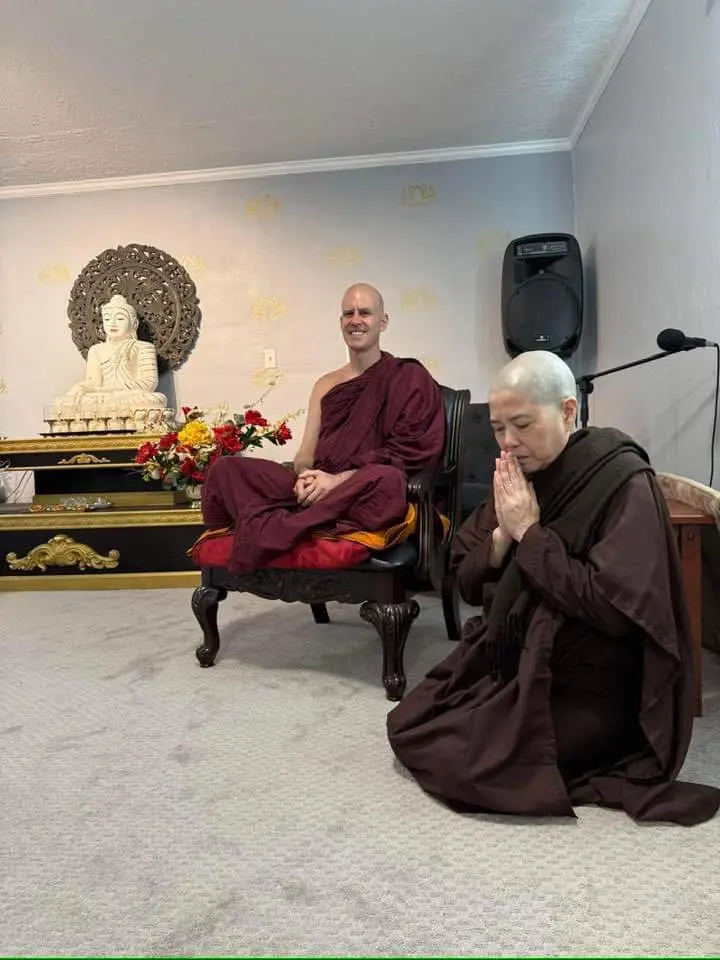What Is An Ordained Sayalay?

Introduction
A Sayalay is an ordained nun in the Myanmar Theravāda Tradition. It is similar to a sāmaṇerī or 10-precept female novice monk. However, to be respectful to the Theravāda tradition, it is not connected or equal to a sāmaṇerī and it is not a stepping stone for a bhikkhunī ordination.
In the Myanmar Theravāda tradition, ordaining as a Sayalay provides women with a distinct path to practice the Dhamma formally without stepping into the roles traditionally reserved for monks or fully ordained bhikkhunīs. The Sayalay lineage honors the essence of monastic life, allowing women to embody the teachings while maintaining harmony within the Theravāda structure.
On November 3, 2024, I ordained my first Sayalay at a very small monastery . Her name is Sayalay Dhammarati, which means “one who delights in the Dhamma.” We will talk about what it means to be a Sayalay.
Preliminary Procedure
First, the ladies shave the head of the nun-to-be. The monk would normally shave the head if it were a male ordination candidate. This is because monks cannot touch women or even their hair.
 Sayalay-to-be is on the far left.
Sayalay-to-be is on the far left.

Then the robes are given to the teacher and then given back to the student. Because this is officially done with a novice ordination, the exchange while giving the robes to the teacher and then back was done in English instead of the official pāḷi language.
Venerable Sir, please accept this robe and out of your compassion ordain me as a sayalay in order that I may realize Nibbāna, the liberation from the entire cycle of suffering.

Ordination Procedure
Once the candidate has the robes and her head shaved, she can then take triple refuge and the 8 or 10 precepts. In this case, 10 precepts were taken (and preferred).
Taking triple refuge in the Buddha, Dhamma, and Saṅgha (the Three Gems) is a central act in Buddhist practice, marking a commitment to follow the path laid down by the Buddha, seek wisdom through the Dhamma, and rely on the guidance of the Saṅgha. By taking the Ten Precepts, the Sayalay dedicates herself to ethical discipline and mental clarity, essential foundations for spiritual progress. These precepts guide her to live in purity, simplicity, and mindfulness, reinforcing her focus on the path to liberation.
Here is a list of the dialog that takes place for the ordination:
Sayalay Ordination Request
Request for Refuge and Ten Precepts
Ahaṃ bhante tisaraṇena saha dasa-pabbajjasīlaṃ dhammaṃ yācāmi.
Anuggahaṃ katvā sīlaṃ detha me bhante.(Venerable Sir, I request the Three Refuges together with the Ten Precepts. Out of compassion, please give me the precepts, Venerable Sir.)
Second Request:
Dutiyampi ahaṃ bhante tisaraṇena saha dasa-pabbajjasīlaṃ dhammaṃ yācāmi.
Anuggahaṃ katvā sīlaṃ detha me bhante.(For a second time, Venerable Sir, I request the Three Refuges together with the Ten Precepts. Out of compassion, please give me the precepts, Venerable Sir.)
Third Request:
Tatiyampi ahaṃ bhante tisaraṇena saha dasa-pabbajjasīlaṃ dhammaṃ yācāmi.
Anuggahaṃ katvā sīlaṃ detha me bhante.(For a third time, Venerable Sir, I request the Three Refuges together with the Ten Precepts. Out of compassion, please give me the precepts, Venerable Sir.)
Formal Recital Confirmation
Monk: Ahaṃ vadāmi, taṃ vadehi.
(I will say it, please repeat it.)Sayalay: Āma, bhante.
(Yes, Venerable Sir.)The Three Refuges
(repeated three times by the sayalay)
Buddhaṃ saraṇaṃ gacchāmi.
(I go to the Buddha for refuge.)
Dhammaṃ saraṇaṃ gacchāmi.
(I go to the Dhamma for refuge.)
Saṅghaṃ saraṇaṃ gacchāmi.
(I go to the Saṅgha for refuge.)Dutiyampi buddhaṃ saraṇaṃ gacchāmi.
(For the second time, I go to the Buddha for refuge.)
Dutiyampi dhammaṃ saraṇaṃ gacchāmi.
(For the second time, I go to the Dhamma for refuge.)
Dutiyampi saṅghaṃ saraṇaṃ gacchāmi.
(For the second time, I go to the Saṅgha for refuge.)Tatiyampi buddhaṃ saraṇaṃ gacchāmi.
(For the third time, I go to the Buddha for refuge.)
Tatiyampi dhammaṃ saraṇaṃ gacchāmi.
(For the third time, I go to the Dhamma for refuge.)
Tatiyampi saṅghaṃ saraṇaṃ gacchāmi.
(For the third time, I go to the Saṅgha for refuge.)Monk: Tisaraṇa gamana sampunnaṃ.
(The going for the Three Refuges is complete.)The Ten Precepts
Pāṇātipātā veramaṇī sikkhāpadaṃ samādiyāmi.
(I undertake the precept to refrain from killing living beings.)Adinnādānā veramaṇī sikkhāpadaṃ samādiyāmi.
(I undertake the precept to refrain from taking what is not given.)Abrahmacariyā veramaṇī sikkhāpadaṃ samādiyāmi.
(I undertake the precept to refrain from sexual misconduct.)Musāvādā veramaṇī sikkhāpadaṃ samādiyāmi.
(I undertake the precept to refrain from false speech.)Surāmeraya-majja-pamādaṭṭhānā veramaṇī sikkhāpadaṃ samādiyāmi.
(I undertake the precept to refrain from intoxicants causing heedlessness.)Vikāla-bhojanā veramaṇī sikkhāpadaṃ samādiyāmi.
(I undertake the precept to refrain from eating at improper times.)Nacca-gīta-vādita-visūka-dassanā veramaṇī sikkhāpadaṃ samādiyāmi.
(I undertake the precept to refrain from entertainment and self-adornment.)Mālā-gandha-vilepana-dhāraṇa-maṇḍana-vibhūsanaṭṭhānā veramaṇī sikkhāpadaṃ samādiyāmi.
(I undertake the precept to refrain from using garlands, perfumes, and cosmetics.)Uccāsayana-mahāsayanā veramaṇī sikkhāpadaṃ samādiyāmi.
(I undertake the precept to refrain from high and luxurious beds.)Jātarūpa-rajata-paṭiggahanā veramaṇī sikkhāpadaṃ samādiyāmi.
(I undertake the precept to refrain from accepting gold and silver.)Additional Blessing
Monk: Tisaraṇena saha pañcasīlaṃ dhammaṃ sādhukaṃ surakkhitaṃ katvā appamādena sampādetha.
(Having well protected the Dhamma of the Five Precepts together with the Three Refuges, accomplish it with diligence.)Laity: Āma, bhante.
(Yes, Venerable Sir.)Monk:
Sīlena sugatiṃ yanti
(Through virtue, one attains a good destination.)
Sīlena bhogasampadā
(Through virtue, one attains wealth.)
Sīlena nibbutiṃ yanti
(Through virtue, one attains Nibbāna.)
Tasmā sīlaṃ visodhaye
(Therefore, one should purify their virtue.)Dedications
Idaṃ me puññaṃ āsavakkhayāvahaṃ hotu.
(May this merit be for the destruction of my taints.)Idaṃ me sīlaṃ nibbānassa paccayo hotu.
(May this virtue be a condition for Nibbāna.)
Differences Between Sāmaṇera and Sayalay Ordinations
There are very few differences. The monk shaves the head and also must inform the saṅgha that a head shaving will take place on that day. The robes are given to the preceptor, and Pāḷi is recited as previously stated. The precepts are taken and only end with “veramaṇī”. It is missing “sikkhāpadaṃ samādiyāmi”. This means that at the end of the 10 precepts, all precepts are taken as a group as a whole. That is the only difference. We intentionally make it slightly different to avoid confusion between sāmaṇerī and sayalay ordination. Ordaining sāmaṇerīs is generally a stepping stone to bhikkhunī ordination. The whole issue of bhikkhunis has caused disharmony in the saṅgha and we don’t want to cause waves.
Why Do The Sayalay Ordination Instead?
This ordination is a way that females can ordain and get all of the benefits of becoming a monastic without the politics of bringing back an official extinct lineage. This new lineage enables nuns to receive support and practice in a similar way. Furthermore, bhikkhunis do indeed have many restrictive rules. Even those who insist on going against the senior teachers and getting such an ordination, choose to ignore some very heavy rules. In this way, we could say that a Sayalay ordination is more conducive to enlightenment since controversy, politics and breaking precepts are hindrances to progress.

Conclusion:
Sayalays enjoy the benefits of female monasticism. They are also not hindered by the overly restrictive rules placed on the original officially extinct lineage of bhikkhunis. Lastly, they are not involved in politics and going against the senior teachers. Ordination is about practice. Ordination is about peace. Ordination is to delight in the Dhamma. Dhammarati. May Sayalay Dhammarati attain the dhamma and find that wonderful delight.
Summary Poem:
In robes of peace, she finds her way,
A path of Dhamma, day by day.
Not bound to titles, yet fully whole,
With virtue pure, she meets her goal.
Threefold Refuge, precepts ten,
A life of calm, renouncing then.
In Myanmar’s way, her heart set free,
A Sayalay—delighting, named “Dhammarati”.
Click below to search subjects